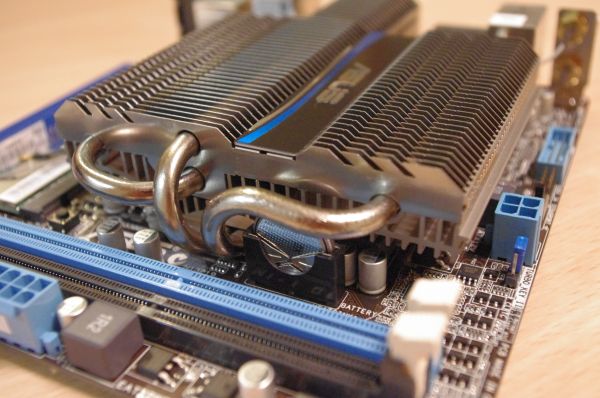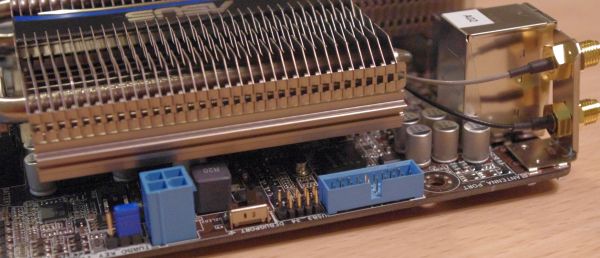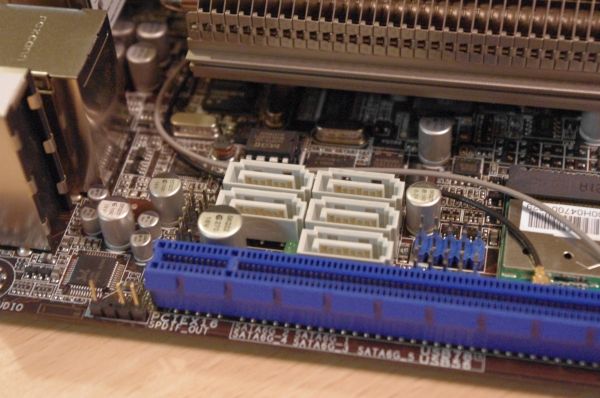Fusion E-350 Review: ASUS E35M1-I Deluxe, ECS HDC-I and Zotac FUSION350-A-E
by Ian Cutress on July 14, 2011 11:00 AM ESTEver since I first tinkered around with the ASUS board, I had a love/hate relationship with it. It's a prime example of what a lot of people may want in a board - it's passive, the wifi is already built in (you just fix the antenna), and it runs straight out of the box. But the more I prodded around the vibrant exterior, I tried to find what I would get for my $175, especially compared to the other boards I have here for review.
Despite the E-350 processor on board, the passive heatsink gets incredibly hot to touch, even at idle in a fanless environment. The CPU itself is rated at 18W, and without a discrete GPU, the board is pulling around 60W in our stringent tests. This is disconcerting, considering that the ECS board (even though it isn't passive) pulls off a 33% overclock. Also, due to the size passive heatsink, the IO panel is hit - the onboard audio has only two outputs and we're limited to DVI and HDMI video. This doesn't happen on the Zotac board, which is also passive.
Visual Inspection
I've mentioned it before and I'll mention it again - heatsink. This motherboard has a massive one, with ASUS on it, just in case you forgot. The heatsink is still shorter than any full height DDR3 memory you put in the DIMM slots, and there are two fan headers found in the top left, just beside the heatsink in that corner.
There is a USB 3.0 header along the top of the board, along with a debug header, a Turbo switch, a 4-pin 12 V CPU connector and the Clear CMOS header. Unfortunately, the writing next to these is all mixed up - the writing above the turbo switch says 'DEBUG PORT' and above the Clear CMOS is 'TURBO_KEY+II'. Nowhere on the board does it say the Clear CMOS is the Clear CMOS - during bad overclocking I had to refer to the manual to find this information.
Thankfully, the front panel connectors are still on the right hand side of the DDR3 DIMM slots (unlike the ECS), and the wifi card is preinstalled in a very tight space the other side of the DIMMs. The five SATA 6 Gbps ports are also here, with USB 2.0 headers, and the MEM OK button which is ASUS' memory adaptation feature if there is incompatibility with any memory module changes. The HD Audio header is on the far left of these headers and ports, which could cause an issue depending on where the cable is coming from and what's installed on the board. There is also a full length PCIe slot - it will accept any 16x peripheral, but run it at 4x speeds, including discrete GPUs.
The I/O panel is a mixture of positive and negative. Because of the large heatsink impinging into the panel, some of the functionality is lost. Alongside the two antenna ports, we have a single PS/2 port, four USB 2.0 ports, two USB 3.0 ports, HDMI (1.3b) and DVI video outputs, optical S/PDIF Out, a Bluetooth receiver, an eSATA 6 Gbps port, an Ethernet port and three audio jacks. The big surprise here is that the HDMI is only 1.3b and not 1.4a...




















67 Comments
View All Comments
ET - Saturday, July 16, 2011 - link
Here are a few links to E-350 reviews using a desktop PSU. Not a comprehensive list by any means:http://www.guru3d.com/article/amd-brazos-platform-...
http://www.overclockersclub.com/reviews/sapphire_f...
http://www.xbitlabs.com/articles/mainboards/displa...
http://www.eteknix.com/motherboards/jetway-nc85-e3...
http://www.tweaktown.com/reviews/4093/asus_e35m1_i...
And of course Anandtech's first review of the platform:
http://www.anandtech.com/show/4134/the-brazos-revi...
ET - Friday, July 15, 2011 - link
In the conclusion you say about the ECS: "Having 33% free of anything is usually a good idea, so when it comes part of the package with very little increase in power consumption, it is a good thing. As a result, all the benchmarks and all the games had much, much higher scores than the other boards we tested."Unfortunately these gaming performance figures don't appear in the article. This looks like an oversight that needs to be corrected.
Mitalca - Friday, July 15, 2011 - link
I second that.Through the review there's a lot of times when Ian talks about the marvell the ECS did with the 33% OC. Then why you didn't show the results?
One of the bigest flaws in this review, that make a lot of people suspect of a way-too-much-biased review.
Testing with a 580 is ridiculous, even if you want to "provide a plausible maximum ceiling". I spend $500 and I only get 50% more frames. What about a U$ 50-100 gpu?? If the CPU and the memory are by far the bottleneck, we should see similar results.
And, once you show the huge benefits that overclocking does to the iGPU, why not try it with the dGPU?
ET - Saturday, July 16, 2011 - link
The main thing I would like to see added to the discrete GPU test is an AMD GPU. The CPU usage of NVIDIA and AMD drivers are different, so results may be different.I don't think that a discrete GPU is worth using with the E-350 in any case, and the test with the GeForce 580 pretty much proved that. It's just too CPU limited.
xorbit - Friday, July 15, 2011 - link
This review is a steaming pile. At least it lends credibility that Anandtech might not be biased, just woefully incompetent.An HTPC review without HTPC benchmarks and coupling the chips with impropper PSU/GPUs.
silverblue - Friday, July 15, 2011 - link
Without wanting to start a huge squabble, if you guys think you could do better...lestr - Friday, July 15, 2011 - link
Tom's already did: Daily Hardware 7/6. 8 boards with more relevant tests though somewhat incomplete.My big question is: WHAT is AMD afraid of? SUCCESS? AMD fanboy but when they could really kick a** they give us another "almost".
Another question: Does the PCIe slot support anything other than graphics? Can I stuff a Hauppauge 2250 or a Ceton card in it? This is totally ignored on almost ALL current ITX boards. You're about as likely to win the Kentucky Derby with a 3-legged horse as playing any games on this platform. What's the point?
The E450 (1.65 / 1333 / HD 6320) is due out any time. Standards on this platform should include 6 audio outs (hello Asus!), mPCIe, fp USB3.. how about DUAL channel memory? What's a few more watts anyway? Is 35W APU too many? RAID?
I wish AMD would pull out all the stops and do this little thing right.. entice the partners as well. If they can't do anything else but bury Atom/NV ... AMD needs to win something sometime.. why not NOW?
Any comments, Ian?
mino - Friday, July 15, 2011 - link
Brazos is sigle channle.There are 35W Llano E2 series APU's on the way.
Brazos is SOLD OUT for 3 quarters allready ... talk about AMD being afraid ...
medi01 - Sunday, July 17, 2011 - link
Idiot detected.Wander7 - Friday, July 15, 2011 - link
Just by looking at the two heatsinks and not doing any measurements, it looks like the Asus' heatsink is suffering from air stagnation because the fins are too close together....